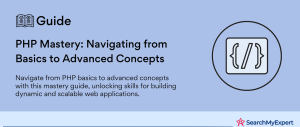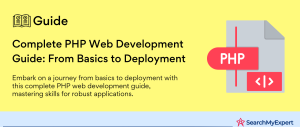The Critical Role of Security in PHP Development: Understanding Risks and Emphasizing Best Practices
In the ever-evolving landscape of web development, PHP stands as a cornerstone language, powering a significant portion of the internet. However, with great power comes great responsibility, particularly concerning security. In this comprehensive exploration, we delve into the pivotal importance of security in PHP development, shedding light on the common vulnerabilities that plague PHP applications and the potential consequences of neglecting security measures. Furthermore, we introduce the concept of “best practices” in PHP security, underscoring their role as a proactive shield against digital threats.
Understanding the Vulnerabilities in PHP Development
- SQL Injection: One of the most prevalent security flaws in PHP applications arises from SQL injection attacks. These occur when attackers manipulate SQL queries by injecting malicious code through input fields, potentially leading to unauthorized access to or manipulation of database information.
- Cross-Site Scripting (XSS):
XSS attacks involve the injection of harmful scripts into web pages viewed by other users. This can result in the theft of cookies, session tokens, or other sensitive information from unsuspecting users. - Cross-Site Request Forgery (CSRF): In CSRF attacks, unauthorized commands are transmitted from a user that the web application trusts. This can lead to unwanted actions being performed on behalf of the user without their knowledge.
- File Upload Vulnerabilities:
Improper handling of file uploads can lead to the server being compromised, especially if the application allows the upload of executable files. - Remote Code Execution:
This occurs when an attacker manages to run malicious code on a server. It is often the result of other vulnerabilities like SQL injection or file upload flaws.
The Dire Consequences of Ignoring PHP Security
Neglecting PHP security can have devastating impacts:
- Data Breaches: Insecure applications can lead to data breaches, exposing sensitive user information, financial data, and confidential business information.
- Financial Losses:
Security breaches often lead to substantial financial losses, either through direct theft or the cost of remediation and damage control. - Reputation Damage:
A security breach can tarnish the reputation of a business, leading to lost trust among customers and partners. - Legal Repercussions:
Companies may face legal consequences for failing to protect user data, especially under regulations like GDPR.
Embracing Best Practices for Proactive PHP Security
To mitigate these risks, it’s crucial to adopt best practices in PHP development:
- Regular Updates:
Keeping PHP and its frameworks updated ensures that known vulnerabilities are patched. - Input Validation and Sanitization: Rigorous input validation and sanitization can prevent SQL injection and XSS attacks.
- Use of Secure Protocols: Implementing HTTPS and other secure communication protocols safeguards data in transit.
- Error Handling:
Proper error handling can prevent the disclosure of sensitive system information. - Regular Security Audits:
Conducting security audits and code reviews can identify and rectify vulnerabilities.
Navigating the Minefield of User Input: A Guide to Validation and Sanitization in PHP
In the intricate web of PHP development, the treatment of user input is a critical factor in maintaining robust security. Ignoring the sanitization of user input can lead to various vulnerabilities, some of which are highlighted in the OWASP Top 10 list. This segment aims to illuminate the risks associated with unsanitized input and outline effective strategies for validating and sanitizing different data types.
Unveiling the Dangers of Unsanitized User Input
- SQL Injection:
This is a formidable threat where unsanitized input is used in SQL statements, potentially leading to unauthorized data access or database manipulation. - Cross-Site Scripting (XSS):
Here, malicious scripts entered by users are executed in other users’ browsers, posing significant risks such as data theft or session hijacking. - Other Risks:
Unsanitized input can also lead to other risks like command injection or path traversal, each carrying its own set of dangers.
Effective Strategies for Data Type-Specific Validation and Sanitization
- For Numbers: Ensure that the input strictly represents a numerical value and falls within expected numerical boundaries.
- For Strings:
It’s crucial to check if the string adheres to the expected format (like email addresses or URLs) and to remove or encode any potentially harmful characters. - For Booleans: Confirm that the input is indeed a Boolean value (true or false), which is often crucial in decision-making processes within the application.
Best Practices in Input Validation and Sanitization
- Employing Prepared Statements:
This is a key practice in preventing SQL injection, which involves using placeholders for parameters in SQL queries. - Utilizing Built-in PHP Functions:
Functions like filter_var are instrumental in validating and sanitizing various data types, such as email addresses and URLs. - Escaping Output:
This practice, essential for preventing XSS, involves treating user input as data, not executable code, especially when outputting to HTML. - Regular Expression Checks: For more complex validations, like ensuring a string follows a specific pattern, regular expressions are a powerful tool.
- Custom Validation Routines: Sometimes, specific use cases require custom validation logic, which should be carefully designed to comprehensively check the input data.
Fortifying PHP Applications: Best Practices for Secure Database Interaction
When it comes to PHP development, the interaction with databases is a critical area where security must be paramount. This section emphasizes the importance of robust practices in database interaction to prevent common vulnerabilities like SQL injection and covers essential strategies for secure database connection management and overall database security.
Preventing SQL Injection: The Role of Prepared Statements and Parameterized Queries
- Crucial Defense Against SQL Injection:
Prepared statements and parameterized queries are the first line of defense against SQL injection attacks. They ensure that user input is treated strictly as data, not as part of the SQL command. - How They Work: By separating SQL logic from data, these methods prevent attackers from altering the intent of a SQL query by injecting malicious code.
Managing Database Connections Securely
- Using Secure Access Credentials:
Always use strong, unique credentials for database access. Storing these credentials securely and keeping them separate from the application code is crucial. - Connection Handling: Efficiently manage database connections by closing them when not in use. This reduces the risk of unauthorized access and potential attacks.
Best Practices for Enhanced Database Security
- Limiting Data Exposure:
Be mindful of the data your queries are accessing. Limit the exposure by requesting only the data necessary for a particular operation. - Implementing Appropriate User Roles: Use database roles and permissions to control the level of access given to different parts of your application. Ensure that each component has only the permissions necessary to perform its function.
- Regular Audits and Updates:
Keep your database software up-to-date and conduct regular audits of your database operations to identify potential security issues. - Data Encryption:
Implement encryption for sensitive data both in transit and at rest. This ensures that even if data is intercepted or accessed improperly, it remains unreadable without the proper encryption keys. - Backup and Recovery Plans:
Have a robust backup and recovery plan in place. Regular backups and a clear recovery strategy are essential in the event of data loss or corruption.
Securing User Identity: Advanced Techniques in Session Management and Authentication for PHP
In the world of PHP development, managing user sessions and authentication is a critical aspect of ensuring a secure user experience. This section explores the role of sessions in user authentication and authorization, dives into secure session handling techniques, and introduces various authentication methods to enhance application security.
Understanding the Role of Sessions in Authentication and Authorization
- Essential for User Identity: Sessions play a crucial role in tracking user interactions with a PHP application. They are pivotal in maintaining user identity after the initial log-in.
- Authorization Checks:
Sessions are used to store user permissions, making it possible to perform authorization checks throughout the application.
Advanced Techniques in Secure Session Handling
- Preventing Session Hijacking: To safeguard against session hijacking, it is vital to use secure, encrypted connections (HTTPS) for transmitting session IDs. Regularly regenerating session IDs, especially after login, also enhances security.
- Session Encryption:
Encrypting session data adds an extra layer of protection, ensuring that sensitive information stored in session variables is not easily accessible. - Proper Session Termination: Ensure sessions are properly terminated upon user logout or after a period of inactivity. This prevents leftover sessions from becoming a security vulnerability.
Diverse Authentication Methods: Enhancing Security Beyond Passwords
- Password Hashing:
Storing passwords in a hashed format is fundamental. Hashing transforms the password into a unique, fixed-size string that cannot be easily reversed. - Two-Factor Authentication (2FA):
This method adds an extra layer of security by requiring two different forms of identification: something the user knows (like a password) and something the user has (like a mobile device). - Token-Based Authentication: Involves generating a secure token during the login process, which the user must provide in subsequent requests. This is particularly useful in stateless applications or APIs.
- OAuth and OpenID Connect:
These are standards for authentication that allow users to log in using their credentials from other trusted services, thereby reducing the risk of password-related breaches. - Biometric Authentication:
Although less common in web applications, biometric authentication (like fingerprint or facial recognition) offers a high level of security and convenience.
Strategic Error Handling and Logging: Essential Pillars of PHP Security
In the intricate tapestry of PHP development, secure error handling and diligent logging are indispensable for maintaining the integrity and confidentiality of an application. This section highlights the significance of secure error handling to prevent the leakage of sensitive information, explores various logging strategies for security events, and underscores the criticality of concealing sensitive error messages from users.
Secure Error Handling: Shielding Sensitive Information
- Concealing System Details:
Secure error handling is pivotal in preventing the exposure of system internals. Displaying detailed error messages can inadvertently reveal sensitive information about the system’s architecture, database schemas, or potentially even credentials. - Custom Error Pages:
Implementing custom error pages ensures that users are not confronted with default error messages that could disclose valuable information to potential attackers.
Logging Strategies: Tracking Security Events and Vulnerabilities
- Comprehensive Logging:
Recording security-related events such as failed login attempts, suspicious activities, and system errors, is key to identifying and tracking potential vulnerabilities. - Balancing Detail and Privacy: Logs should contain enough detail to be useful for security analysis, but not so much that they inadvertently store sensitive user information.
- Regular Monitoring and Analysis: Regularly reviewing logs helps in promptly identifying suspicious patterns or security breaches, allowing for timely intervention.
The Imperative of Hiding Sensitive Error Messages from Users
- Exposing Only Necessary Information: Users should receive only the information needed to understand that an error has occurred, without details that could be exploited for malicious purposes.
- Utilizing Logging for Diagnostics:
While user-facing messages should be generic, detailed error information should be logged internally for diagnostic purposes. This allows developers to investigate and address issues without compromising security. - Implementing Different Error Modes:
Employing different modes for error display (such as ‘development’ vs. ‘production’ modes) ensures that detailed errors are only displayed in a secure development environment.
Reinforcing Security Through File System and Permissions in PHP
In PHP development, managing the file system and permissions is a critical aspect of securing an application. This segment focuses on the risks associated with insecure file system permissions and user uploads, outlines best practices for setting file permissions and validating file uploads, and delves into techniques for securely storing and accessing application files.
Understanding the Risks of Insecure File System Permissions and User Uploads
- Potential for Unauthorized Access:
Insecure file permissions can leave the door open for unauthorized users to access or modify files, potentially leading to data leaks or system compromise. - Vulnerability from User Uploads:
Allowing users to upload files without proper validation can be a major security risk, as malicious files can be uploaded to the server, posing a threat to the system and its data.
Best Practices for File Permissions and File Upload Validation
- Setting Correct File Permissions:
It’s crucial to set appropriate permissions on files and directories. Generally, the principle of least privilege should be applied, granting only the necessary permissions to each file and directory. - Validating File Uploads:
Always validate file uploads both on the client side and server side. This includes checking the file size, type, and scanning for malware. - Restricting File Types:
Limit the types of files that can be uploaded to prevent the execution of potentially harmful scripts.
Techniques for Secure File Storage and Access
- Storing Files Outside Web Root: Store uploaded files outside of the web root when possible. This prevents direct access to the files via a URL.
- Using Secure Methods to Serve Files:
If access to uploaded files is necessary, use secure methods to serve them, such as PHP scripts that control access based on user permissions. - Regularly Backing Up Files:
Regular backups of important files can prevent data loss and aid in recovery in case of a security incident. - Implementing Access Controls:
Implement access controls for files, ensuring that users can only access files that they are authorized to view or modify.
Navigating Third-Party Libraries and Frameworks: A Security Perspective for PHP Developers
In the dynamic world of PHP development, third-party libraries and frameworks are indispensable for enhancing functionality and efficiency. However, their integration brings its own set of security considerations. This section discusses the potential security risks associated with third-party components, emphasizes the importance of choosing reputable libraries, and offers guidance on securely maintaining and updating these dependencies.
Unpacking the Security Risks of Third-Party Libraries and Frameworks
- Vulnerability Exposure:
Third-party components can introduce vulnerabilities into your application. These vulnerabilities might be unknown to the developer but known to attackers, making them an easy target. - Dependency Chain Risks: Libraries often depend on other libraries, creating a chain of dependencies. A vulnerability in any link of this chain can compromise the entire application.
Selecting Reputable Libraries and Frameworks with Strong Security Practices
- Research and Reputation:
Opt for libraries and frameworks that are well-known and widely used in the community. Their popularity often means they are more regularly scrutinized and updated. - Security Track Record:
Check the library’s history for security issues and how promptly they were addressed. A good track record of responding to security issues is a positive indicator. - Community and Support: A strong, active community and availability of support can be crucial for addressing security issues quickly.
Tips for Securely Maintaining and Updating Third-Party Dependencies
- Regular Updates: Keep all libraries and frameworks up-to-date. Developers often release updates to patch known security vulnerabilities.
- Use Dependency Management Tools:
Tools like Composer for PHP can help manage your libraries, making it easier to keep them updated. - Audit Your Libraries:
Regularly audit your third-party components for vulnerabilities. Tools like security scanners can automate this process. - Understanding Changes:
When updating a library, understand what changes are being made and how they might affect your application’s security. - Remove Unused Dependencies: If a library or framework is no longer used in your application, remove it to reduce the potential attack surface.
Conclusion:
In this comprehensive guide, we have navigated through the crucial aspects of PHP security, providing insights and strategies to fortify PHP applications. From the initial steps of input validation and sanitization to the complexities of secure session management, error handling, and dealing with third-party libraries, we’ve covered a spectrum of best practices and techniques essential for modern PHP development.
Unleash your project’s potential with PHP Development Service.
Table of Contents
Toggle






